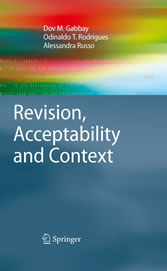Suchen und Finden
Preface
5
Contents
7
1 Background and Overview
11
1.1 Introductory Discussion
11
1.2 Focusing on `Acceptability' Rather than `Inconsistency'
15
1.3 Overview of This Book
17
1.4 Notation Used in This Book
18
1.5 Basic Mathematical Notions
20
References
21
2 Introducing Revision Theory
23
2.1 AGM Belief Revision
23
2.2 Katsuno and Mendelzon's Characterisation
30
2.3 Counterfactual Statements and the Ramsey Test
31
2.4 Grove's Systems of Spheres
35
2.5 Epistemic Entrenchment
38
2.6 Discussion
40
2.7 Action Updates
40
2.8 Generalising the Concept of Revision
43
2.9 Iterating the Revision Operation
47
2.9.1 Darwiche and Pearl's Postulates for Iterated Revisions
47
2.9.2 Lehmann's Approach: Belief Revision, Revised
50
2.10 Compromise Revision
51
2.11 Controlled Revision
55
2.12 Revision by Translation
57
2.13 A General Setting for Algorithmic Revision
59
2.14 Outline of This Book
62
References
62
3 Stepwise Revision Operations
65
3.1 Introduction
65
3.2 Quantitative Measurement of Change
65
3.2.1 Minimal Change and the Function d
66
3.3 Qualitative Measurements of Change
73
3.4 Representation Issues
75
3.5 Revision of Formulae
77
3.6 Properties of the Revision Operator r
80
3.7 Other Belief Change Operators
87
3.7.1 Belief Contraction
87
3.7.2 Consolidating Information on the Belief Base
92
3.8 Comparison with Other Belief Change Operators
95
3.9 Operators for Reasoning About the Effects of Actions
98
3.9.1 Updates of Sentences via Distance d
99
3.9.2 Properties of the Action Update Operator
103
3.9.3 Action Updates of Sentences via Distance diff
106
3.9.4 Ambiguous Action Updates
108
3.9.5 Taking Causality into Account
110
References
112
4 Iterating Revision
114
4.1 Introduction
114
4.2 Motivating Structure for Belief Revision
116
4.3 Iteration of the Revision Operation
117
4.4 Prioritised Databases
120
4.4.1 Properties of the Revisions of PDBs
124
4.4.2 Discussion about Iteration of Revision
128
4.5 Structured Databases
133
4.6 Applications and Examples
135
4.7 Related Work
137
4.7.1 Prioritised Base Revision
137
4.7.2 Ordered Theory Presentations
140
4.8 Using Additional Information for Action Updates
141
References
145
5 Structured Revision
147
5.1 Identifying Inconsistency
147
5.2 Reasoning with Partial Priorities
156
5.2.1 Degree of Confidence/Reliability of the Source
157
5.2.2 Linearisations
173
5.3 Clustering
174
5.4 Applications in Software Engineering
176
5.4.1 Requirements Specification
176
5.4.2 An Example with the Light Control System
177
References
183
6 Algorithmic Context Revision
185
6.1 Introduction
185
6.2 Abductive Revision
185
6.2.1 Introducing LDS for
188
6.2.2 Goal-Directed Algorithm for
191
6.2.3 Discussion on the Abduction Procedure
195
6.2.4 Abduction Algorithm for
200
6.2.5 Abduction for Intuitionistic Logic
202
6.3 Compromise Revision
205
6.3.1 Introducing Compromise Revision for
205
6.3.2 Comparison with AGM Revision
218
6.4 Controlled Revision
222
6.4.1 Proof Theory
224
6.4.2 Policies for Inconsistency
225
6.4.3 Conclusions
229
References
230
7 Revision by Translation
231
7.1 Introduction
231
7.2 Belief Revision for Modal Logic
233
7.2.1 An Overview of Propositional Modal Logics
233
7.2.2 Hilbert Systems for Modal Logics
238
7.2.3 Translation of the Modal Logic K into Classical Logic
241
7.3 Revising in ukasiewicz' Finitely Many-Valued Logic n
243
7.3.1 ukasiewicz' Finitely Many-Valued Logic n
243
7.3.2 Translating ukasiewicz' Many-Valued Logic n into Classical Logic
249
7.3.3 Revision in ukasiewicz' Many-Valued Logic ( n)
252
7.4 Revising in Algebraic Logics
254
7.4.1 Translating Algebraic Logic into Classical Logic
254
7.4.2 Revision in Algebraic Logics
256
7.5 Introducing Belnap's Four-Valued Logic
257
7.5.1 Belief Revision in Belnap's Four-Valued Logic
257
7.6 Belnap's Four-Valued Logic
259
7.6.1 Axiomatising Belnap's Four-Valued Logic
259
7.6.2 Entailment in Belnap's Four-Valued Logic
261
7.6.3 Generalising Belnap's Notion of Entailment to Infinite Theories
263
7.6.4 Translating Belnap's Logic into Classical Logic
267
7.6.5 Revising in Belnap's Four-Valued Logic
273
7.7 Conclusions and Discussions
276
References
277
8 Object-Level Deletion
279
8.1 Introduction
279
8.2 Object-Level Meta-Level Operations
279
8.3 The Need for Object-Level Deletion
282
8.4 Strategy of the Technique
287
8.5 Substructural Logics
289
8.5.1 Hilbert and Gentzen Formulations
290
8.5.2 Goal-Directed Proof Theory
296
8.5.3 Semantics
305
8.6 Introducing Anti-formulae in Concatenation and Linear Logic
312
8.6.1 Analysis
313
8.6.2 Introducing Anti-formulae into Logics with and e
318
8.6.3 Anti-formulae and Negation
323
8.7 The Notion of Failure in Resource Logics
329
8.8 Deletion in Resource-Unbounded Logics
333
8.9 Logical Deletion in LDS
335
8.10 Introducing N-Prolog with Negation as Failure
344
8.11 Exploring Deletion via Addition
352
8.12 A Formal System for Deletion via Addition
361
8.13 Concluding Remarks
363
References
366
9 Conclusions and Discussions
367
9.1 Concluding Remarks
367
9.2 Discussions
372
References
382
List of Symbols
384
Subject Index
386
Alle Preise verstehen sich inklusive der gesetzlichen MwSt.









